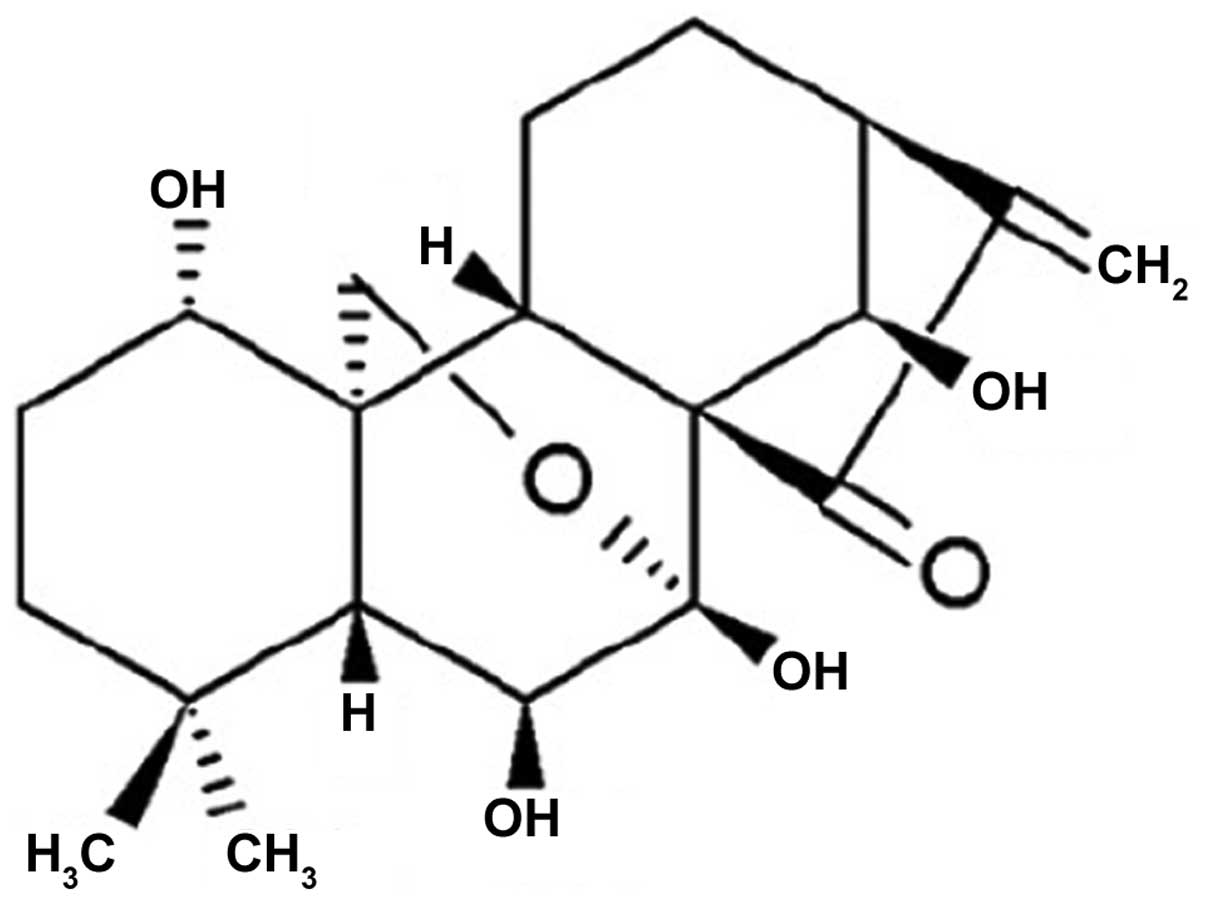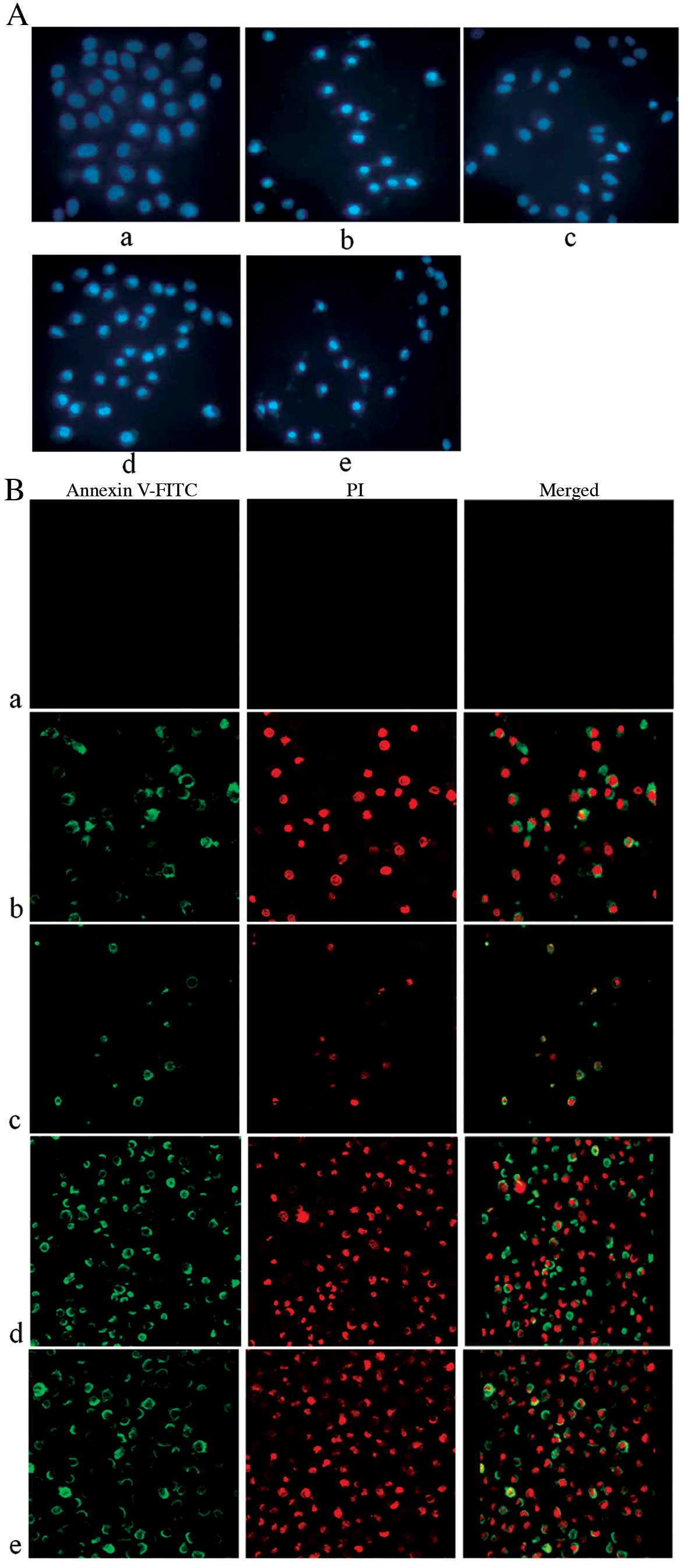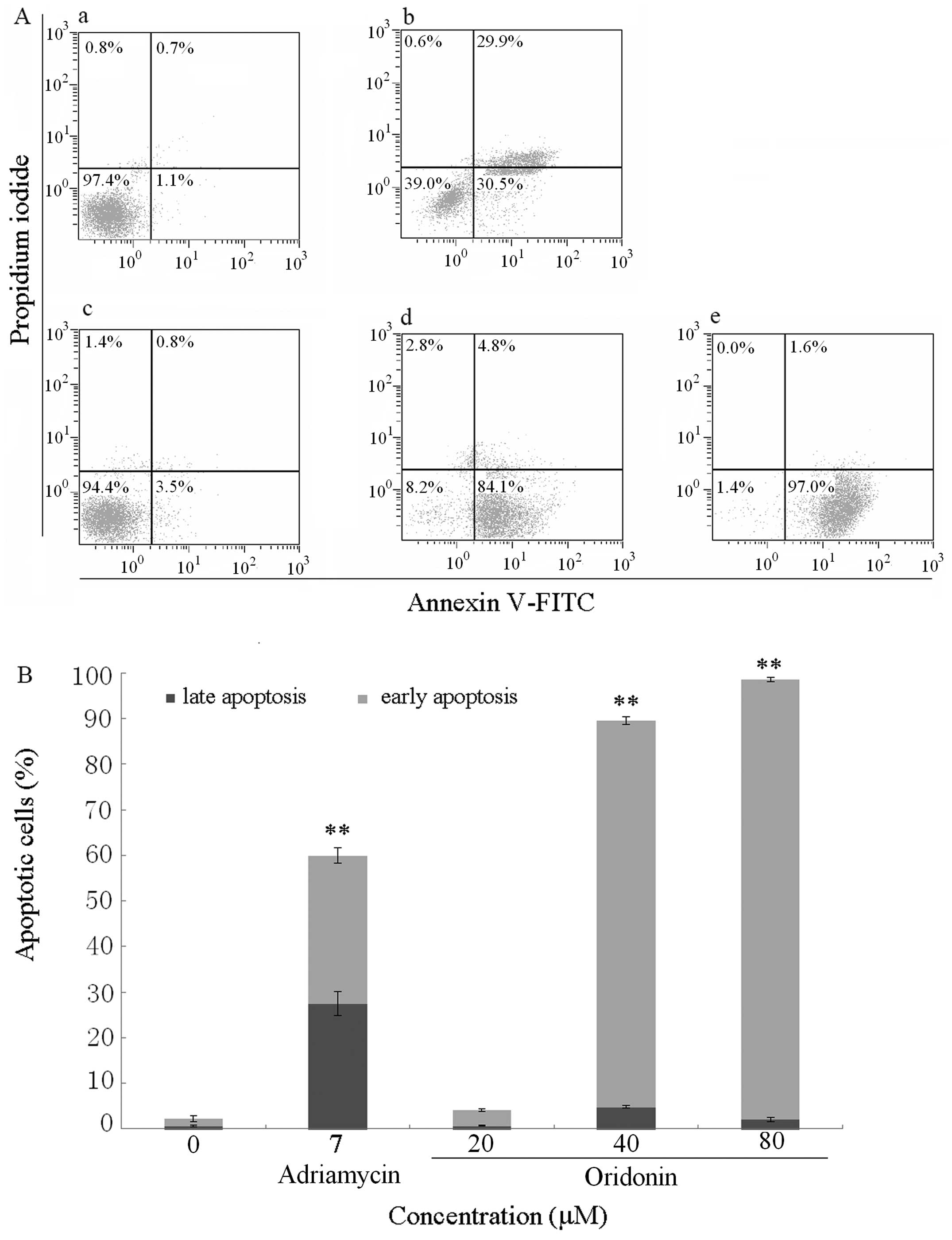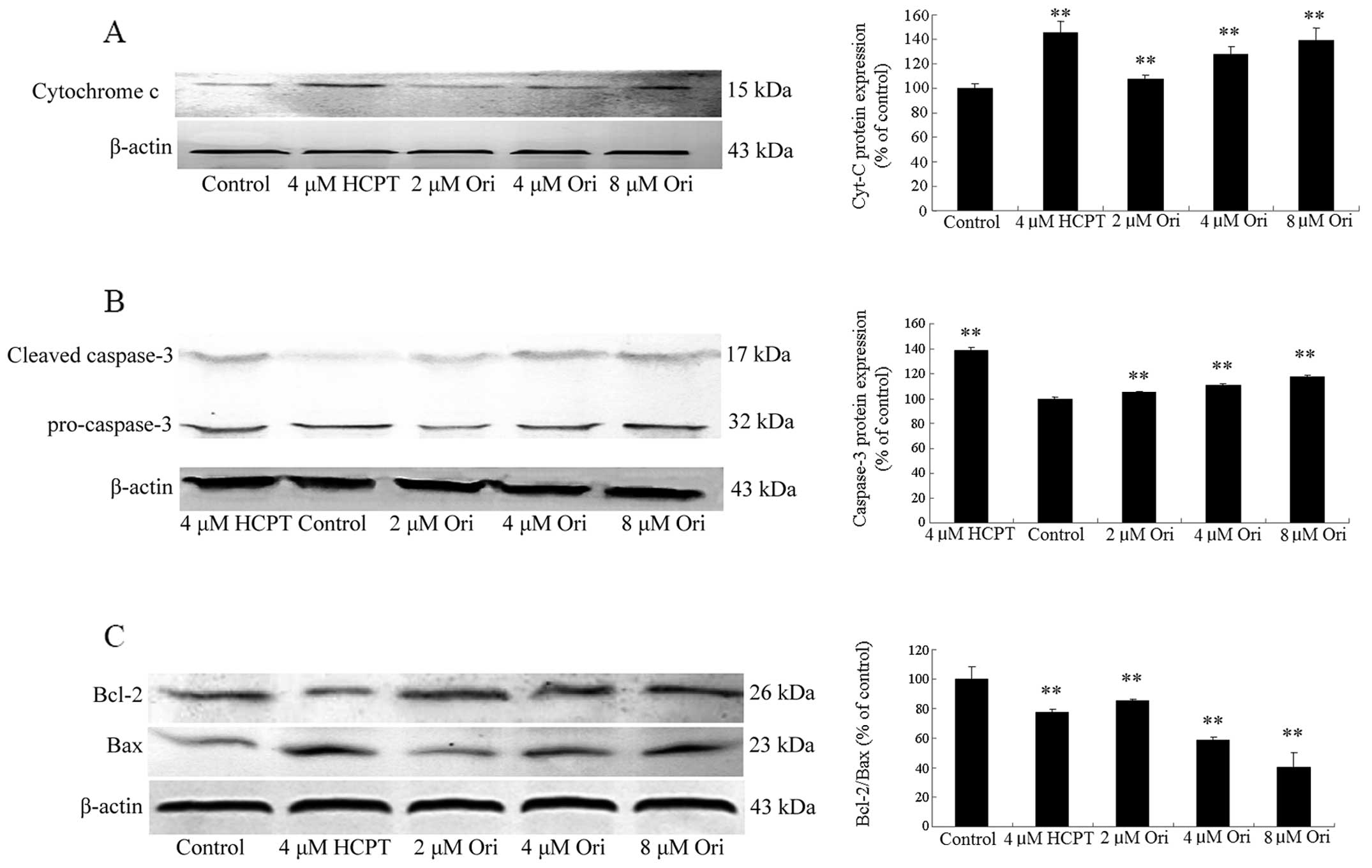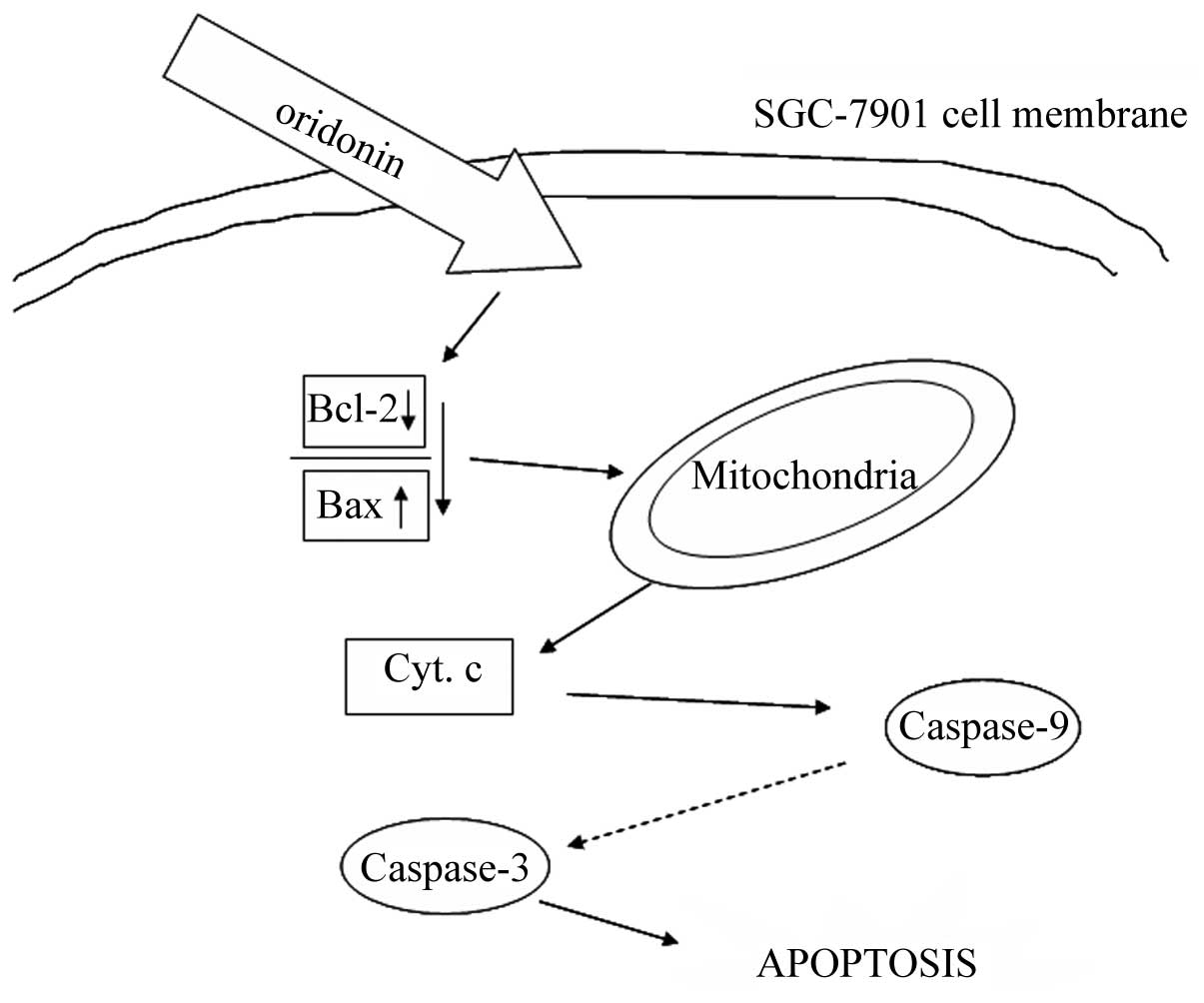Oridonin induces apoptosis through the mitochondrial pathway in human gastric cancer SGC-7901 cells
- Authors:
- Published online on: April 7, 2016 https://doi.org/10.3892/ijo.2016.3479
- Pages: 2453-2460
Abstract
Introduction
Gastric cancer is one of the most common malignant tumors worldwide. In less developed countries, stomach cancers are also leading causes of cancer death, which is generally about twice as high in men as in women (1). The incidence and mortality rates vary widely across countries, the highest in high-income Asia Pacific, east Asia, and Andean Latin America (2), which was related to dietary patterns, food storage, and the availability of fresh produce.
Chemotherapy is widely used in cancer treatment, it shows better therapy effect, but toxic and side effects cause serious harm to cancer patients. Recently, research interest has turned to the traditional medicine, and investigations of new anticancer drugs with low toxicity. Rabdosia rubescens, a medical plant, has been used to treat cancer in China for a long time (3), and has been reported to show better effects in the treatment of urinary bladder carcinoma (4), esophageal carcinoma (5,6), prostate cancer (7), and oridonin is one of the most important antitumor active ingredient of Rabdosia rubescens (8,9).
Oridonin, molecular formula C20H28O6 (Fig. 1), is a diterpenoid compound (10). Previous studies have shown that oridonin has antitumor activities in vivo and in vitro (11–13), and oridonin inhibited proliferation of cancer cells by inducing autophagic pathways (14–18), arresting the cell cycle on G0/G1 phase (19) or G2/M phase (20–24), inducing apoptosis of human laryngeal cancer cells (25), esophageal cancer (26), colorectal carcinoma (27), pancreatic cancer (28), hepatocellular carcinoma (29,30). However, few reports exist on oridonin-induced apoptosis on gastric cancer. Therefore, this study explored apoptosis and related protein expression induced by oridonin on human gastric cancer SGC-7901 cells.
Materials and methods
Chemicals and other reagents
Oridonin (>98%) was purchased from National Institutes for Food and Drug Control (Beijing, China). Doxorubicin was obtained from Pharmacia Italia S.p.A., Gaggiano, Italy. Hydroxycamptothecin (HCPT) was provided by Shanghai Longxiang Biological Medicine Development Co. Ltd. (Shanghai, China). Dimethyl sulfoxide (DMSO), trypsin, Tris, glycine, acrylamide, methylene diacrylamide and Tween-20 were purchased from Sigma-Aldrich (St. Louis, MO, USA). RPMI-1640 cell culture medium was purchased from Gibco (Grand Island, NY, USA). Fetal calf serum (FCS) was purchased from Sijiqing Hangzhou Bio Engineering Co., Ltd. (Hangzhou, China). Hoechst33342, Annexin V-FITC apoptosis detection kit, DAB Horseradish Peroxidase Color Development kit were obtained from the Beyotime Institute of Biotechnology (Jiangsu, China). Antibodies for cytochrome c, Bcl-2, Bax, caspase-3, cleaved-caspase-3, β-actin, and the secondary antibodies were purchased from ZSGB-BIO (Beijing, China). All other chemicals and solvents used were the highest purity grade.
Cell line and culture conditions
The human gastric cancinoma SGC-7901 cell line was obtained from American Type Culture Collection (Manassas, VA, USA). The cells were cultured in RPMI-1640 supplement with 10% (v/v) fetal bovine serum (FBS) and antibiotics (100 IU/ml of penicillin and 100 μg/ml of streptomycin) at 37°C in a humidified atmosphere containing 5% CO2.
Cell viability and cytotoxicity
The cultured cells at the exponential growth phase were harvested from the culture flasks by trypsin and then re-suspended in fresh RPMI-1640 medium. The cell suspensions were dispensed into a 96-well microplate at 100 μl/well and placed in an incubator with 5% CO2 at 37°C. After 24 h, 100 μl various concentrations of oridonin were added and incubated for 72 h. Then the medium was discarded and 100 μl of MTT stock solution (1 mg/ml) was added. After incubation for 4 h, DMSO (150 μl) was added to each well to solubilize the water-insoluble purple formazan crystals. The amount of MTT-formazan is directly proportional to the number of living cells and was determined by measuring the optical density (OD) at 570 nm using microplate reader (model 680; Bio-Rad Laboratories, Hercules, CA, USA). The percentage of cytotoxic activity compared to the untreated cells was determined, and the IC50 was calculated by the Logit method.
Cell nuclear morphology observation (Hoechst 33342)
Morphology of apoptotic cell was observed by Hoechst 33342 staining assay. The cells were washed in phosphate-buffered saline (PBS) and fixed in formaldehyde solution (4%, w/v) for 30 min. Then the fixed cells were stained with 10 mg/ml Hoechst 33342 for 10 min, and nuclear morphology was observed under a fluorescence microscopy (Leica, Wetzlar, Germany) equipped with a digital camera.
Confocal laser scanning microscopy assay
Qualitative experiment of apoptosis was observed by confocal laser scanning microscopy after staining cells with the Annexin V-FITC apoptosis detection kit (MultiSciences Biotech Co., Ltd., Hangzhou, China). SGC-7901 cells (1.5×105 cells/well) were placed on 6-well plates and incubated with oridonin for 24 h. The cells were stained by Annexin V-FITC (green fluorescence) in the dark for phosphatidylserine (PS) examination. Then cells were stained with PI (red fluorescence) in the dark for nucleus examination. Stained cells were visualized by confocal laser scanning microscopy (Leica, SP2, Wetzlar, Germany) equipped with 488 nm Argon lasers (31).
Flow cytometric analysis of apoptosis
Early apoptosis rate were measured using the Annexin V-FITC apoptosis detection kit (MultiSciences Biotech Co. Ltd., China) as described in the supplier instructions. After exposure to oridinin (0, 20, 40 and 80 μM) for 24 h, cells were harvested by centrifugation, washed twice with PBS, and resuspended in Binding Buffer, 5 μl of Annexin V-FITC and 5 μl of propidium iodide (PI, 50 mg/ml) was added and incubated at room temperature in the dark. The data acquisition and analysis were performed using MultiCycle software flow cytometry (Beckman Coulter, XL, USA).
Total protein extraction and western blot assay
SGC-7901 cells were treated with different concentration of oridonin. For isolation of total protein fractions, cells were collected, washed twice with cold PBS, and lysed with cell lysis buffer (50 mM Tris-Cl, pH 8.0, 120 mM NaCl, 50 mM NaF, 200 μM sodium vanadate, 0.5% NP-40, 10 mM phenylmethylsulfonyl fluoride (PMSF), 2 μg/ml aprotinin 0.2 μl, 10 μg/ml leupeptin 10 μl). The lysates were centrifuged at 12000 × g for 10 min at 4°C, the supernatant was saved at −20°C. Protein concentrations of cell lysates were detected by Bradford assay (32). Total protein samples were separated by SDS-PAGE. The separated proteins were transferred to NC membranes. After being blocked with blocking solution (5% skim milk in TBS, 10 mM Tris-HCl, 150 mM NaCl, pH 7.5 plus 0.1% Tween-20) at room temperature for 2 h. Each membrane was incubated with primary antibodies overnight at 4°C. Afterwards, the membranes were probed with the appropriate horseradish-peroxidase conjugated secondary antibody for 2 h at room temperature. Detection was performed by the DAB Horseradish Peroxidase Color Development kit (Beyotime Institute of Biotechnology) according to the manufacturer's instructions. Bands were recorded and relative density units of the bands were analyzed by Gel Imaging System (Tanon, GIS-2019, Beijing, China). Densitometrical data of multiple experiments are shown.
Statistical analysis
The data are presented as the mean ± SD. Statistical significance was calculated using Student's t-test. P-values of ≤5% were considered to indicate statistically significant differences.
Results
Effect of oridonin on SGC-7901 cell viability
In order to evaluate the effect of oridonin on proliferation of the SGC-7901 cells, the cells were treated with different concentrations of oridonin for 72 h, the cell viability was quantitated by MTT assay. The results showed that oridonin inhibited the proliferation of SGC-7901 cells, and the IC50 was 22.74 μM. The results are shown in Table I.
Table IDoses inducing 50% cell growth inhibition (IC50) of oridonin against human gastric cancer SGC-7901 cells. |
Effect of oridonin on SGC-7901 cell nuclei morphology
The results above can significantly demonstrate that oridonin possessed notable antitumor activity on human gastric cancer SGC-7901 cells. To determine whether the antitumor activity of oridonin was due to induction of apoptosis, SGC-7901 cells were stained with Hoechst 33342 to examine the nuclear morphological changes. The results showed that cells of the control group had normal nuclear morphology and the dye of Hoechst 33342 was evenly distributed under fluorescent microscope, which indicated that the chromatin was equivalently distributed in the nucleus. However, after treatment with different concentrations of oridonin for 24 h, the characteristic features of apoptosis (including marked nuclear fragmentation, nuclear blebbing, condensation of chromatin, and emitting brighter fluorescence) was clearly detected in the SGC-7901 cells under the inverted fluorescence microscope (Fig. 2Ac–e). These results indicated that oridonin induced cell apoptosis in human gastric carcinoma.
Effect of oridonin on SGC-7901 cell membrance morphology
In order to confirm whether oridonin induced cell apoptosis, we applied the assay of Annexin V-FITC stain for detection of phosphatidylserine (PS), the biochemical marker of apoptosis. PS is normally located in the inner plasma membrane, however, in the early apoptosis the PS is transferred to its outer surface. Annexin V-FITC combined with PS of the outer surface of the membrance and emit green fluorescent. After treatment with different concentrations of oridonin for 24 h, SGC-7901 cells were stained by Annexin V-FITC (green fluorescence) and PI (red fluorescence), and observed and photographed by laser scanning confocal microscopy. The results showed that a large number of cells treated with oridonin were positively stained by Annexin V-FITC (Fig. 2Bc–e). Which showed that oridonin was able to induce SGC-7901 cell apoptosis.
Oridonin induces early apoptosis rate of SGC-7901 cells
To quantify the apoptotic rate of oridonin on SGC-7901 cells, the Annexin V-FITC/PI staining and flow cytometry was adopted. The data obtained showed that oridonin induced early apoptosis of SGC-7901 cells in a dose-dependent manner (Fig. 3 and Table II). When the cells were treated with 0, 20, 40, 80 μmol/l oridonin for 24 h, the average proportion of Annexin V-staining positive cells and PI-staining negative cells (early apoptotic cells) significantly increased from 1.53%±0.67% in control to 3.33%±0.29, 84.80%±0.82 and 96.43%±0.51%, respectively (Table I). Fig. 3B shows the graphic representation of the increase in the early apoptotic cells with increase in the dose of oridonin.
Oridonin affects apoptosis-associated protein expression in SGC-7901 cells
Whether or not oridonin induced apoptosis in SGC-7901 cell through the effects of apoptosis-associated protein, western blots were adopted to examined the protein expression of mitochondrial pathway of SGC-7901 cell treated with 2, 4, 8 μM oridonin. The analysis results showed that all concentrations of oridonin (2, 4, 8 μM) resulted in a significant increase of cytochrome c (Fig. 4A) and remarkable cleavage of caspases-3 were detected compared with the control group (Fig. 4B). Mitochondrial dysfunction is regulated by Bcl-2 family proteins, thus the Bcl-2 family proteins were examined in the study. Oridonin caused a significant reduction in Bcl-2 expression whereas the expression of Bax was significantly increased, which led to decrease of Bcl-2/Bax in a concentration-dependent manner (Fig. 4C). Thus, oridonin could induce apoptosis in SGC-7901 cells with mitochondrial pathway involved.
Discussion
Rabdosia rubescens are used in Chinese folk medicine for treatment of esophageal cancer in Taihang Mountains area of China for a long time. Research showed that oridonin was one of the most important antitumor active ingredient of Rabdosia rubescens (33–36). Our previous studies showed that oridonin could arrest the cell cycle in G2/M phase in human gastric cancer SGC-7901 cells (3). G2/M phase cell cycle arrest induced by oridonin would cause cell apoptosis, in order to confirm this hypothesis, we observed apoptotic effect of oridonin on SGC-7901 cells and the expression of apoptosis related protein, which has scarely been reported in SGC-7901 gastric cancer cells.
In the Hoechst 33342 assay, cells stained by Hoechst33342 were observed by fluorescence microscopy, a classic method to distinguish apoptotic cells, normal cells and necrotic cells (37,38). A small amount of Hoechst 33342 could penetrate the normal cell membranes and emit equivalent dark blue fluorescence after combination with DNA. However, lighter blue fluorescence was emitted in the apoptotic cells, because of membrane permeability enhancement, a large amount of Hoechst 33342 penetration, DNA breakage and function inactivation of P-glycoprotein. The fluorescence was darker in the necrotic cells than that in apoptotic cells because the structure of DNA of necrotic cells is unbroken. Thus, the fluorescence of apoptotic cells were lighter than that in the normal cells and the necrotic cells. As shown in Fig. 2Aa, cells of the control group had normal nuclear morphology under fluorescent microscope after Hoechst 33342 staining, indicating that the chromatin was equivalently distributed in the nucleus. The test group cells marked with irregular nuclei, crescent-shaped nuclei, condensation of chromatin and the morphological characteristics of apoptosis, which include emitting brighter fluorescence (Fig. 2Ac–e), were detected after treatment with different concentrations of oridonin for 24 h. These results indicated that oridonin is capable of inducing apoptosis in SGC-7901 cells.
In order to further evaluate whether oridonin could induce apoptosis in SGC-7901 cells, the cells were treated with the stain of Annexin V-FITC/PI and detected by confocal microscopy. The results showed that a large number of cells treated by oridonin were positively stained by Annexin V-FITC (Fig. 2Bc–e), which showed that oridonin could induce SGC-7901 cell apoptosis. The conclusion was consistent with that detected by Hoechst 33342 assay.
After qualitative research of apoptosis induced by oridonin, cells stained with Annexin V-FITC/PI were detected by flow cytometer to quantify the early apoptotic rate induced by oridonin. The percentage of live, early apoptotic, late apoptotic and dead cells were calculated. The results showed that oridonin was able to induce apoptosis of SGC-7901 cells (Fig. 3 and Table II), which was visible from the percentage increase in mean fluorescence intensity in the early apoptotic stages of the treated cells when compared to the control.
It is well known that apoptosis can be regulated by apoptotic related protein. Bcl-2 family members and caspase family members play important roles in inducing cell apoptosis. The Bcl-2 family proteins, such as the anti-apoptotic protein bcl-2 and the pro-apoptotic protein bax, could enhance the membrane permeability of the mitochondria, which results in cytochrome c release from mitochondria to the cytoplasm (39). Cytochrome c is combined with apoptosis protease activating factor-1, recruits and cleaves procaspase-9, and activates caspase-3, which is responsible for apoptosis (40). In order to examine the underlying mechanism of apoptosis of oridonin, the respective expression of Bcl-2, Bax, cytochrome c and cleaved caspase-3 was examined.
Based on the results from western blot analysis, oridonin increased the protein expression of Bax, and decreased the protein expression of Bcl-2 (Fig. 4C). The ratio of Bcl-2/Bax expression was decreased. Which led to cytochrome c release to the cytoplasm, as shown on the results (Fig. 4A) oridonin also increased the expression of cytochrome c in the cytoplasm in SGC-7901 cells. These observations suggest that oridonin induced apoptosis of SGC-7901 cells via mitochondria-dependent pathway.
Caspase-3, one of the family members of cysteinyl aspartate proteases, is an executioner enzyme inducing apoptosis (41). Mitochondrial pathway (42), death receptor-mediated pathway (43) and endoplasmic reticulum pathway (44) are the major signal transduction pathways that induced apoptosis (45,46), which ultimately induce cell apoptosis by activating caspase-3 (47). We found that oridonin evoked caspase-3 activation, as evidenced by the appearance of 17 kDa subunits, which showed that oridonin induced SGC-7901 apoptosis was caspase-3 dependent.
In conclusion, the possible significant molecular signal pathways for oridonin inducing apoptosis in SGC-7901 cells is shown in Fig. 5. Oridonin may decrease the ratio of Bcl-2/Bax, which lead to dysfunction of mitochondria and cause cytochrome c release, then activate the caspase-3 leading to apoptosis. The present study demonstrated that oridonin induced apoptosis in SGC-7901 cells via the mitochondrial signal pathway, which may represent one of the major mechanisms of oridonin-mediated apoptosis in SGC-7901 cells.
Acknowledgements
This study was financially supported by Science and Technology Innovation Team Program in Higher Education Institutions of Heilongjiang Province (2014TD009), and the Program for New Century Excellent Talents in Heilongjiang Provincial University (1251-NCET-019), Science and Technology Research Project of Heilongjiang Province Department of Education (12541571).
References
|
Torre LA, Bray F, Siegel RL, Ferlay J, Lortet-Tieulent J and Jemal A: Global cancer statistics, 2012. CA Cancer J Clin. 65:87–108. 2015. View Article : Google Scholar : PubMed/NCBI | |
|
Fitzmaurice C, Dicker D, Pain A, Hamavid H, Moradi-Lakeh M, MacIntyre MF, Allen C, Hansen G, Woodbrook R, Wolfe C, et al; Global Burden of Disease Cancer Collaboration. The global burden of cancer 2013. JAMA Oncol. 1:505–527. 2015. View Article : Google Scholar : PubMed/NCBI | |
|
Gao SY, Li J, Qu XY, Zhu N and Ji YB: Downregulation of Cdk1 and cyclinB1 expression contributes to oridonin-induced cell cycle arrest at G2/M phase and growth inhibition in SGC-7901 gastric cancer cells. Asian Pac J Cancer Prev. 15:6437–6441. 2014. View Article : Google Scholar : PubMed/NCBI | |
|
Xu PY, Zhao GX and Chang LS: Local thermotherapy with rabdosia liquid as prophylactic measure for recurrence of superficial urinary bladder carcinoma: A non-randomized contemporary controlled study. Zhongguo Zhong Xi Yi Jie He Za Zhi. 25:1115–1117. 2005.(In Chinese). | |
|
Wang RL: A report of 40 cases of esophageal carcinoma surviving for more than 5 years after treatment with drugs. Zhonghua Zhong Liu Za Zhi. 15:300–302. 1993.(In Chinese). PubMed/NCBI | |
|
Wang RL, Gao BL, Xiong ML, Mei QD, Fan KS, Zuo ZK, Lang TL, Gao GQ, Ji ZC, Wei DC, et al: Potentiation by Rabdosia rubescens on chemotherapy of advanced esophageal carcinoma. Zhonghua Zhong Liu Za Zhi. 8:297–299. 1986.(In Chinese). PubMed/NCBI | |
|
de la Taille A, Hayek OR, Burchardt M, Burchardt T and Katz AE: Role of herbal compounds (PC-SPES) in hormone-refractory prostate cancer: Two case reports. J Altern Complement Med. 6:449–451. 2000. View Article : Google Scholar : PubMed/NCBI | |
|
Lou H, Gao L, Wei X, Zhang Z, Zheng D, Zhang D, Zhang X, Li Y and Zhang Q: Oridonin nanosuspension enhances anti-tumor efficacy in SMMC-7721 cells and H22 tumor bearing mice. Colloids Surf B Biointerfaces. 87:319–325. 2011. View Article : Google Scholar : PubMed/NCBI | |
|
Wang C, Jiang L, Wang S, Shi H, Wang J, Wang R, Li Y, Dou Y, Liu Y, Hou G, et al: The antitumor activity of the novel compound jesridonin on human esophageal carcinoma cells. PLoS One. 10:e01302842015. View Article : Google Scholar : PubMed/NCBI | |
|
Shen J, Zhang D, Zhao Z, Jia L, Zheng D, Liu G, Hao L, Zhang Q, Tian X, Li C, et al: Synthesis, characterization, in vitro and in vivo evaluation of PEGylated oridonin conjugates. Int J Pharm. 456:80–86. 2013. View Article : Google Scholar : PubMed/NCBI | |
|
Zhou GB, Kang H, Wang L, Gao L, Liu P, Xie J, Zhang FX, Weng XQ, Shen ZX, Chen J, et al: Oridonin, a diterpenoid extracted from medicinal herbs, targets AML1-ETO fusion protein and shows potent antitumor activity with low adverse effects on t(8;21) leukemia in vitro and in vivo. Blood. 109:3441–3450. 2007. View Article : Google Scholar : PubMed/NCBI | |
|
Lou H, Zhang X, Gao L, Feng F, Wang J, Wei X, Yu Z, Zhang D and Zhang Q: In vitro and in vivo antitumor activity of oridonin nanosuspension. Int J Pharm. 379:181–186. 2009. View Article : Google Scholar : PubMed/NCBI | |
|
Wang CJ, Zhu GJ, Yu L and Shi BH: Preparation, in vitro, and in vivo antitumor activity of folate receptor-targeted nanoliposomes containing oridonin. Drug Dev Res. 74:43–49. 2013. View Article : Google Scholar | |
|
Ye LH, Li WJ, Jiang XQ, Chen YL, Tao SX, Qian WL and He JS: Study on the autophagy of prostate cancer PC-3 cells induced by oridonin. Anat Rec (Hoboken). 295:417–422. 2012. View Article : Google Scholar | |
|
Ye YC, Wang HJ, Xu L, Liu WW, Liu BB, Tashiro S, Onodera S and Ikejima T: Oridonin induces apoptosis and autophagy in murine fibrosarcoma L929 cells partly via NO-ERK-p53 positive-feedback loop signaling pathway. Acta Pharmacol Sin. 33:1055–1061. 2012. View Article : Google Scholar : PubMed/NCBI | |
|
Yu Y, Fan SM, Song JK, Tashiro S, Onodera S and Ikejima T: Hydroxyl radical (·OH) played a pivotal role in oridonin-induced apoptosis and autophagy in human epidermoid carcinoma A431 cells. Biol Pharm Bull. 35:2148–2159. 2012. View Article : Google Scholar | |
|
Zang L, He H, Ye Y, Liu W, Fan S, Tashiro S, Onodera S and Ikejima T: Nitric oxide augments oridonin-induced efferocytosis by human histocytic lymphoma U937 cells via autophagy and the NF-κB-COX-2-IL-1β pathway. Free Radic Res. 46:1207–1219. 2012. View Article : Google Scholar : PubMed/NCBI | |
|
Liu Y, Liu JH, Chai K, Tashiro S, Onodera S and Ikejima T: Inhibition of c-Met promoted apoptosis, autophagy and loss of the mitochondrial transmembrane potential in oridonin-induced A549 lung cancer cells. J Pharm Pharmacol. 65:1622–1642. 2013. View Article : Google Scholar : PubMed/NCBI | |
|
Hsieh TC, Wijeratne EK, Liang JY, Gunatilaka AL and Wu JM: Differential control of growth, cell cycle progression, and expression of NF-kappaB in human breast cancer cells MCF-7, MCF-10A, and MDA-MB-231 by ponicidin and oridonin, diterpenoids from the chinese herb Rabdosia rubescens. Biochem Biophys Res Commun. 337:224–231. 2005. View Article : Google Scholar : PubMed/NCBI | |
|
Zhang T, Tan Y, Zhao R and Liu Z: DNA damage induced by oridonin involves cell cycle arrest at G2/M phase in human MCF-7 cells. Contemp Oncol (Pozn). 17:38–44. 2013. | |
|
Wang H, Ye Y, Chui JH, Zhu GY, Li YW, Fong DWF and Yu ZL: Oridonin induces G2/M cell cycle arrest and apoptosis through MAPK and p53 signaling pathways in HepG2 cells. Oncol Rep. 24:647–651. 2010.PubMed/NCBI | |
|
Qi X, Zhang D, Xu X, Feng F, Ren G, Chu Q, Zhang Q and Tian K: Oridonin nanosuspension was more effective than free oridonin on G2/M cell cycle arrest and apoptosis in the human pancreatic cancer PANC-1 cell line. Int J Nanomed. 7:1793–1804. 2012. | |
|
Cheng Y, Qiu F, Ye YC, Tashiro S, Onodera S and Ikejima T: Oridonin induces G2/M arrest and apoptosis via activating ERK-p53 apoptotic pathway and inhibiting PTK-Ras-Raf-JNK survival pathway in murine fibrosarcoma L929 cells. Arch Biochem Biophys. 490:70–75. 2009. View Article : Google Scholar : PubMed/NCBI | |
|
Kang N, Zhang JH, Qiu F, Chen S, Tashiro S, Onodera S and Ikejima T: Induction of G(2)/M phase arrest and apoptosis by oridonin in human laryngeal carcinoma cells. J Nat Prod. 73:1058–1063. 2010. View Article : Google Scholar : PubMed/NCBI | |
|
Kang N, Cao SJ, Zhou Y, He H, Tashiro S, Onodera S, Qiu F and Ikejima T: Inhibition of caspase-9 by oridonin, a diterpenoid isolated from Rabdosia rubescens, augments apoptosis in human laryngeal cancer cells. Int J Oncol. 47:2045–2056. 2015.PubMed/NCBI | |
|
Pi J, Cai H, Jin H, Yang F, Jiang J, Wu A, Zhu H, Liu J, Su X, Yang P, et al: Qualitative and quantitative analysis of ROS-mediated oridonin-induced oesophageal cancer KYSE-150 cell apoptosis by atomic force microscopy. PLoS One. 10:e01409352015. View Article : Google Scholar : PubMed/NCBI | |
|
Yang J, Jiang H, Wang C, Yang B, Zhao L, Hu D, Qiu G, Dong X and Xiao B: Oridonin triggers apoptosis in colorectal carcinoma cells and suppression of microRNA-32 expression augments oridonin-mediated apoptotic effects. Biomed Pharmacother. 72:125–134. 2015. View Article : Google Scholar : PubMed/NCBI | |
|
Bu HQ, Liu DL, Wei WT, Chen L, Huang H, Li Y and Cui JH: Oridonin induces apoptosis in SW1990 pancreatic cancer cells via p53- and caspase-dependent induction of p38 MAPK. Oncol Rep. 31:975–982. 2014. | |
|
Cai DT, Jin H, Xiong QX, Liu WG, Gao ZG, Gu GX and Qiu YH: ER stress and ASK1-JNK activation contribute to oridonin-induced apoptosis and growth inhibition in cultured human hepatoblastoma HuH-6 cells. Mol Cell Biochem. 379:161–169. 2013. View Article : Google Scholar : PubMed/NCBI | |
|
Zhu M, Hong D, Bao Y, Wang C and Pan W: Oridonin induces the apoptosis of metastatic hepatocellular carcinoma cells via a mitochondrial pathway. Oncol Lett. 6:1502–1506. 2013.PubMed/NCBI | |
|
Hsia TC, Yu CC, Hsu SC, Tang NY, Lu HF, Huang YP, Wu SH, Lin JG and Chung JG: Cantharidin induces apoptosis of H460 human lung cancer cells through mitochondria-dependent pathways. Int J Oncol. 45:245–254. 2014.PubMed/NCBI | |
|
Bradford MM: A rapid and sensitive method for the quantitation of microgram quantities of protein utilizing the principle of protein-dye binding. Anal Biochem. 72:248–254. 1976. View Article : Google Scholar : PubMed/NCBI | |
|
Meade-Tollin LC, Wijeratne EMK, Cooper D, Guild M, Jon E, Fritz A, Zhou GX, Whitesell L, Liang JY and Gunatilaka AAL: Ponicidin and oridonin are responsible for the antiangiogenic activity of Rabdosia rubescens, a constituent of the herbal supplement PC SPES. J Nat Prod. 67:2–4. 2004. View Article : Google Scholar : PubMed/NCBI | |
|
Wong AM, Zhang Y, Kesler K, Deng M, Burhenn L, Wang D, Moro A, Li Z and Heber D: Genomic and in vivo evidence of synergy of a herbal extract compared to its most active ingredient: Rabdosia rubescens vs. oridonin Exp Ther Med. 1:1013–1017. 2010. | |
|
Ikezoe T, Yang Y, Bandobashi K, Saito T, Takemoto S, Machida H, Togitani K, Koeffler HP and Taguchi H: Oridonin, a diterpenoid purified from Rabdosia rubescens, inhibits the proliferation of cells from lymphoid malignancies in association with blockade of the NF-kappa B signal pathways. Mol Cancer Ther. 4:578–586. 2005. View Article : Google Scholar : PubMed/NCBI | |
|
Chen S, Gao J, Halicka HD, Huang X, Traganos F and Darzynkiewicz Z: The cytostatic and cytotoxic effects of oridonin (Rubescenin), a diterpenoid from Rabdosia rubescens, on tumor cells of different lineage. Int J Oncol. 26:579–588. 2005.PubMed/NCBI | |
|
Kim KH, Kim JY, Kwak JH and Pyo S: Different anticancer effects of Saxifragifolin A on estrogen receptor-positive and estrogen receptor-negative breast cancer cells. Phytomedicine. 22:820–828. 2015. View Article : Google Scholar : PubMed/NCBI | |
|
Krajarng A, Imoto M, Tashiro E, Fujimaki T, Shinjo S and Watanapokasin R: Apoptosis induction associated with the ER stress response through up-regulation of JNK in HeLa cells by gambogic acid. BMC Complement Altern Med. 15:262015. View Article : Google Scholar : PubMed/NCBI | |
|
An T, Zhang Y, Huang Y, Zhang R, Yin S, Guo X, Wang Y, Zou C, Wei B, Lv R, et al: Neuregulin-1 protects against doxorubicin-induced apoptosis in cardiomyocytes through an Akt-dependent pathway. Physiol Res. 62:379–385. 2013.PubMed/NCBI | |
|
Nishida K, Yamaguchi O and Otsu K: Crosstalk between autophagy and apoptosis in heart disease. Circ Res. 103:343–351. 2008. View Article : Google Scholar : PubMed/NCBI | |
|
Mazur AJ, Nowak D, Mannherz HG and Malicka-Błaszkiewicz M: Methotrexate induces apoptosis in CaSki and NRK cells and influences the organization of their actin cytoskeleton. Eur J Pharmacol. 613:24–33. 2009. View Article : Google Scholar : PubMed/NCBI | |
|
Kumar S, Yedjou CG and Tchounwou PB: Arsenic trioxide induces oxidative stress, DNA damage, and mitochondrial pathway of apoptosis in human leukemia (HL-60) cells. J Exp Clin Cancer Res. 33:422014. View Article : Google Scholar : PubMed/NCBI | |
|
Tian CL, Wen Q and Fan TJ: Cytotoxicity of atropine to human corneal epithelial cells by inducing cell cycle arrest and mitochondrion-dependent apoptosis. Exp Toxicol Pathol. 67:517–524. 2015. View Article : Google Scholar : PubMed/NCBI | |
|
Broecker-Preuss M, Viehof J, Jastrow H, Becher-Boveleth N, Fuhrer D and Mann K: Cell death induction by the BH3 mimetic GX15-070 in thyroid carcinoma cells. J Exp Clin Cancer Res. 34:692015. View Article : Google Scholar : PubMed/NCBI | |
|
Fulda S: Caspase-8 in cancer biology and therapy. Cancer Lett. 281:128–133. 2009. View Article : Google Scholar | |
|
Danial NN and Korsmeyer SJ: Cell death: Critical control points. Cell. 116:205–219. 2004. View Article : Google Scholar : PubMed/NCBI | |
|
Sun Y, Gao C, Luo M, Wang W, Gu C, Zu Y, Li J, Efferth T and Fu Y: Aspidin PB, a phloroglucinol derivative, induces apoptosis in human hepatocarcinoma HepG2 cells by modulating PI3K/Akt/GSK3β pathway. Chem Biol Interact. 201:1–8. 2013. View Article : Google Scholar |



